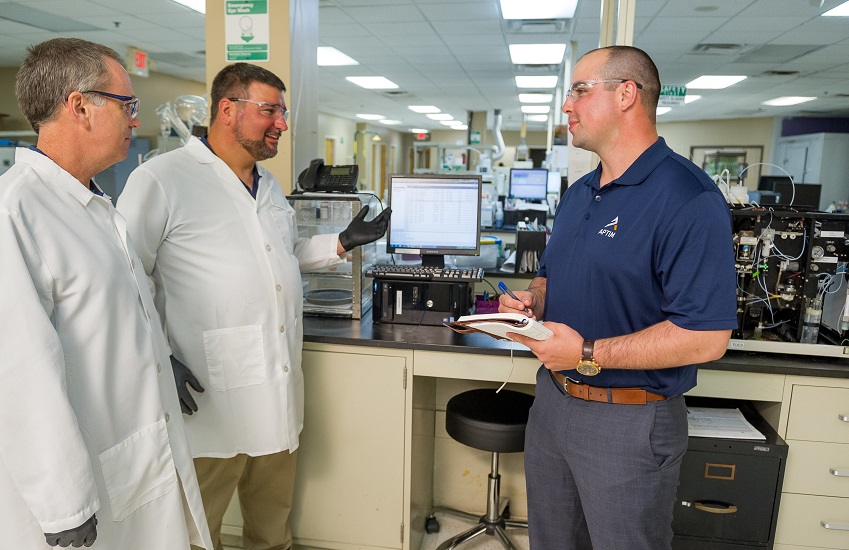Applied Research & Development

The Biotechnology Development and Applications Group at APTIM is an industry-leading R&D lab with more than 20 years’ experience designing and supplying innovative bioremediation solutions for emerging and challenging contaminants to advance effective, timely site remediation.
The Treatability Lab: Biotechnology Development and Applications Group
APTIM’s ability to provide leading edge remediation solutions has been lasting and augmented by our research and development laboratory. APTIM’s Biotechnology Development and Applications Group (BDAG) has designed technology-based experiments and remedies for a wide range of subsurface conditions for more than 20 years. The BDAG occupies a 17,000 square foot laboratory and pilot-plant facility in southern New Jersey. A fully staffed APTIM analytical laboratory is part of the BDAG research facility.
Provider of Biological Cultures to Enhance Bioremediation
Bioremediation has become a primary option for in situ treatment of chlorinated solvents. The BDAG is the largest developer and supplier of commercial Dehalococcoides and other bioaugmentation cultures in the remediation industry and maintains expertise on the application of these cultures. The dechlorination cultures and consulting on their best application are available to all APTIM clients and projects.
Cultures are also available to support the degradation of a number of other contaminants, including MtBE (methyl-tert-butyl ether) and TBA (tert-butyl alcohol), 1,4-dioxane, N-nitrosodimethylamine (NDMA), petroleum hydrocarbons, and 1,2-dibromoethane (EDB).
Address New and Emerging Contaminants of Concern
Remediation programs often address a common set of contaminants, but from time to time new and emerging contaminants of concern are identified where there are limited proven options for concentration reduction. As a leading R&D laboratory, the BDAG initiates the laboratory and field trials needed to find new remedial alternatives.
Many of the BDAG past and current projects have been awarded competitively through governmental research grants, from the SERDP and ESTCP organizations among others, while private sector studies are also common. The remedies and strategies have broad application, and BDAG scientists actively participate in technology transfer through online training with ITRC and SERDP/ESTCP, presentations at scientific meetings, and publication of over 200 research articles and book chapters.
Some recent examples of technology development include:
- Evaluation of catalytic and sorptive technologies to treat per- and polyfluoroalkyl substances (PFAS)
- Assessment of the fate of PFAS in vadose soils at an AFFF site
- Evaluation of in situ adsorptive technologies for PFAS
- Exploration of PFAS transformation by bacteria and wetland plants
- Development of an off-the-grid gas injection system to treat dilute cis-DCE and vinyl chloride in groundwater
- Field tests of co-metabolic approaches for biodegrading chlorinated solvents, 1,4-dioxane, 1,2-dibromoethane(EDB) and N-nitrosodimethylamine (NDMA) in groundwater
- Evaluation of methanotrophs for degradation of chlorinated solvents at low pH
- Development of isotope methods to distinguish natural from synthetic perchlorate
- Development of isotope methods to document biodegradation and natural attenuation of both hexahydro-1,3,5-trinitro-1,3,5-triazine (RDX) and 1,2-dibromoethane (EDB)
- Production of biological cultures customized for site conditions
- Development of an in situ “peeper” technology for assessment of geochemistry, contaminant concentrations, and microbial communities in low permeability aquifer formations
Design “Flask to Field” Tests for New Technologies
New remediation technologies often start in the lab, are modified to allow testing in the field, and then scale-up for commercial applications. The BDAG has a unique capability to design and conduct a wide array of large- and small-scale treatability studies based on client needs. Partnering with our client organizations deliver bigger benefits, from patents and publications to industry leadership, and ultimately broader opportunities to commercially collaborate.
Our goal is the development of cost-effective technologies that offer high certainty in the timely completion of remediation activities to benefit our clients, negotiate the Record of Decision, and move the site to closure.
Analytics Capabilities
The BDAG also includes a large analytical laboratory with the capability of conducting a variety of routine and unique analyses, often with rapid turn-around. Among the unique capabilities are the analysis of parameters that are important for in situ bioremediation of chlorinated solvents, such as dissolved hydrogen, methane, ethene, ethene, and fatty acids. The chemists in the analytical laboratory also have experience in the development of new or modified techniques for specialty analysis.
APTIM. In Pursuit of Better.
